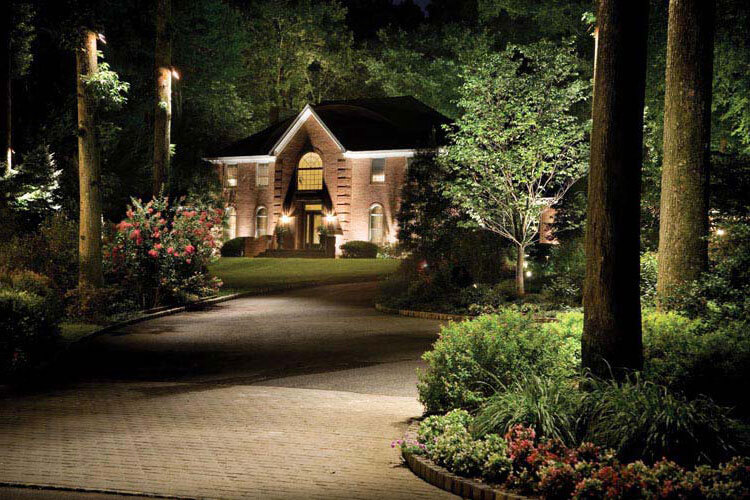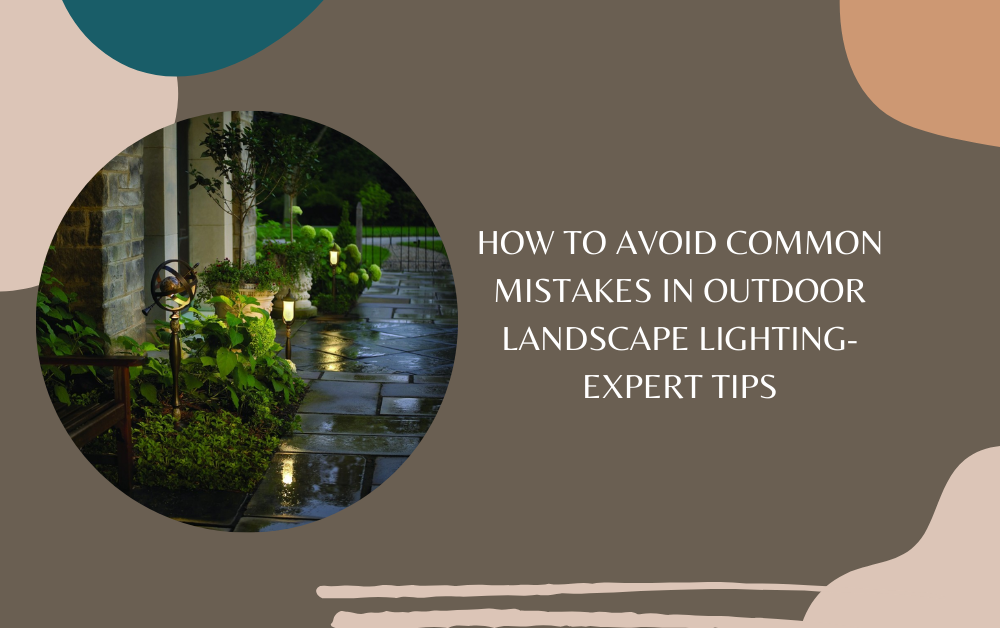Introduction: The Importance of Proper Outdoor Lighting
One of the most common mistakes in outdoor landscape lighting is overlighting. While it might seem like more light equals better illumination, too much light can create a harsh, glaring environment that detracts from the natural beauty of your landscape. Overlighting can also lead to increased energy consumption and light pollution.
Outdoor landscape lighting can transform your garden or yard into a magical nighttime haven, enhancing both its beauty and functionality. However, many homeowners make common mistakes when installing outdoor lighting, leading to ineffective, unattractive, or even hazardous results. Understanding these pitfalls and learning how to avoid them can help you achieve a stunning and safe outdoor lighting setup. This article delves into the most frequent mistakes in outdoor landscape lighting and provides expert advice on how to sidestep them, ensuring your outdoor spaces are perfectly illuminated.
How to Avoid Overlighting
To avoid overlighting, focus on creating layers of light rather than flooding the entire area with brightness. Use a combination of ambient, task, and accent lighting to achieve a balanced and pleasing effect. For instance, use path lights to guide walkways, spotlights to highlight key features, and soft ambient lighting to create a warm glow. Consider using dimmers and timers to adjust the lighting intensity based on the time of day and your specific needs. This approach not only enhances the aesthetic appeal of your outdoor space but also ensures energy efficiency. By carefully planning the placement and type of lighting, you can create a more inviting and functional outdoor environment.
Ignoring Light Pollution
Light pollution is another significant issue that arises from improper outdoor lighting. It not only affects the environment but can also disturb your neighbors and interfere with your enjoyment of the night sky. Light pollution occurs when artificial light spills into areas where it is not needed or wanted, such as into the windows of neighboring homes or upwards into the sky.
How to Minimize Light Pollution
To minimize light pollution, choose lighting fixtures with proper shielding to direct light downward rather than outward or upward. Use fixtures that focus light exactly where it’s needed and avoid using overly bright lights. Opt for warmer light temperatures, as they are less likely to contribute to light pollution compared to cooler, blue-tinted lights. Additionally, consider using motion sensors or timers to ensure lights are only on when necessary, reducing unnecessary illumination and energy consumption. By implementing these strategies, you can enjoy your outdoor spaces without contributing to light pollution.
Inadequate Planning
Another common mistake is failing to plan adequately before installing outdoor lighting. Without a clear plan, you might end up with poorly placed lights that do not achieve the desired effect, or worse, create safety hazards.
The Importance of a Lighting Plan
Creating a detailed lighting plan is crucial for successful outdoor lighting. Start by identifying the key areas you want to illuminate, such as pathways, main entrances, and landscape features. Sketch out your garden or yard, marking where each light will be placed. Consider the power sources and ensure you have access to electricity where needed. Planning ahead allows you to visualize the final result and make adjustments before installation, ensuring a cohesive and functional lighting design. This preparation can save time, money, and effort in the long run.
Using the Wrong Fixtures
Using the wrong type of light fixtures can lead to various issues, from insufficient lighting to excessive maintenance requirements. Different areas of your landscape require specific types of lighting to achieve the best results.

Choosing the Right Fixtures
To choose the right fixtures, consider the purpose of each light. Path lights are ideal for illuminating walkways, while spotlights are perfect for highlighting trees and architectural features. Floodlights work well for broad, intense illumination, and wall lights can enhance the aesthetics of your home’s exterior. Ensure that the fixtures you select are suitable for outdoor use and can withstand the elements. Investing in high-quality, durable fixtures will save you time and money in the long run. Proper fixture selection can enhance the beauty and functionality of your landscape while reducing maintenance needs.
Poor Placement of Lights
Improper placement of lights can result in uneven illumination, dark spots, and glare. Placing lights too close together or too far apart can disrupt the balance and effectiveness of your lighting scheme.
Tips for Proper Light Placement
When placing lights, think about the purpose and the effect you want to achieve. For pathway lighting, space the lights evenly to create a continuous glow without dark gaps. For accent lighting, position the lights to highlight specific features without creating shadows or glare. Use different heights and angles to add depth and dimension to your landscape. Experiment with various placements before finalizing your setup to find the perfect balance. Proper light placement ensures a cohesive and visually appealing lighting design.
Neglecting Maintenance
Once installed, outdoor lights require regular maintenance to function correctly and maintain their appearance. Neglecting maintenance can lead to dirty, damaged, or malfunctioning lights that detract from the beauty and safety of your landscape.
Maintaining Your Outdoor Lights
Regularly clean your light fixtures to remove dirt, debris, and insect buildup. Check for damaged or burnt-out bulbs and replace them promptly. Inspect the wiring and connections to ensure everything is secure and in good working order. Trim any overgrown plants or branches that may obstruct the light. Scheduling periodic maintenance checks will keep your lighting system in top condition and extend its lifespan. Regular maintenance is essential for ensuring the longevity and effectiveness of your outdoor lighting.
Using Inconsistent Lighting
Inconsistent lighting can create a disjointed and chaotic appearance in your outdoor space. Mixing different styles, colors, or intensities of light can be distracting and diminish the overall effect.
Achieving Consistency in Lighting
To achieve a consistent look, choose a cohesive lighting style that complements your home and landscape design. Stick to a limited color palette and consistent light temperatures to create a unified appearance. Use similar fixtures and materials to maintain harmony throughout your outdoor space. Planning your lighting design with a focus on consistency will result in a more polished and aesthetically pleasing environment. Consistent lighting enhances the overall visual appeal of your landscape.
Not Considering Energy Efficiency
Energy efficiency is a critical consideration for outdoor lighting. Using inefficient lighting can lead to high energy bills and unnecessary environmental impact.
Opting for Energy-Efficient Solutions
Choose energy-efficient lighting options, such as LED bulbs, which consume less energy and have a longer lifespan compared to traditional incandescent bulbs. Consider solar-powered lights for areas with sufficient sunlight exposure. Utilize timers, dimmers, and motion sensors to reduce energy consumption and ensure lights are only on when needed. Prioritizing energy efficiency not only saves money but also contributes to a more sustainable and eco-friendly home. Energy-efficient lighting solutions benefit both your wallet and the environment.
Skimping on Quality
Choosing low-quality fixtures and bulbs to save money is a common mistake that can cost more in the long run. Poor-quality lights may fail prematurely, require frequent replacements, and provide subpar illumination.
Investing in Quality Lighting
Invest in high-quality, durable lighting fixtures and bulbs. Look for products from reputable manufacturers that offer warranties and have positive reviews. While the initial cost may be higher, quality lighting solutions are more reliable, require less maintenance, and provide better performance over time. High-quality fixtures are designed to withstand the elements, ensuring longevity and consistent illumination. Investing in quality lighting enhances the reliability and durability of your outdoor lighting system.
Failing to Incorporate Control Options
Neglecting to include control options such as dimmers, timers, and motion sensors can result in a less efficient and less convenient lighting system. These controls enhance the functionality and flexibility of your outdoor lighting.
Integrating Control Options
Incorporate control options into your lighting design to enhance convenience and efficiency. Dimmers allow you to adjust the brightness of your lights to suit different occasions and preferences. Timers can automatically turn your lights on and off at set times, ensuring your property is well-lit when needed and conserving energy when it’s not. Motion sensors add an extra layer of security by activating lights only when movement is detected, deterring potential intruders and saving energy. Control options provide flexibility and improve the overall effectiveness of your lighting system.
Overlooking Safety and Compliance
Ignoring safety considerations and local regulations can lead to hazardous installations and potential legal issues. Proper installation and compliance with electrical codes are essential for safe and effective outdoor lighting.
Ensuring Safety and Compliance
Hire a qualified electrician to install your outdoor lighting system, especially for hardwired fixtures. Ensure that all wiring and electrical components meet local codes and standards. Use weatherproof and waterproof fixtures and fittings to protect against moisture and environmental damage. Additionally, consider the placement of lights to avoid creating trip hazards or blinding glare that could cause accidents. Ensuring safety and compliance is crucial for preventing accidents and legal issues.
Not Balancing Function and Aesthetics
Focusing solely on either functionality or aesthetics can result in an unbalanced lighting design that fails to meet all your needs. Both aspects are important for creating a harmonious and effective outdoor lighting scheme.
Achieving Balance in Lighting Design
Strive to balance function and aesthetics in your lighting design. Functional lighting ensures safety and usability, while aesthetic lighting enhances the beauty of your landscape. Combine practical elements such as path lights and floodlights with decorative fixtures like string
lights and garden lanterns to create a cohesive and visually appealing environment. Thoughtful placement and selection of fixtures will result in a well-lit, beautiful, and functional outdoor space. Achieving a balance between function and aesthetics ensures a practical and visually pleasing lighting design.
Conclusion: Creating a Well-Lit and Beautiful Outdoor Space
Avoiding common mistakes in outdoor landscape lighting can significantly enhance the beauty, functionality, and safety of your outdoor spaces. By understanding these pitfalls and implementing the expert tips provided in this article, you can create a stunning and efficient lighting setup. Remember to plan thoroughly, choose the right fixtures, place lights strategically, and maintain your system regularly. Prioritizing energy efficiency and minimizing light pollution will also contribute to a more sustainable and enjoyable outdoor environment. With careful consideration and attention to detail, your landscape lighting can transform your property into a breathtaking nighttime oasis. By following these guidelines and avoiding common mistakes, you can enjoy a well-lit, safe, and beautiful outdoor space year-round.
Note :- To Read More Articles Visit on- theincblogs

